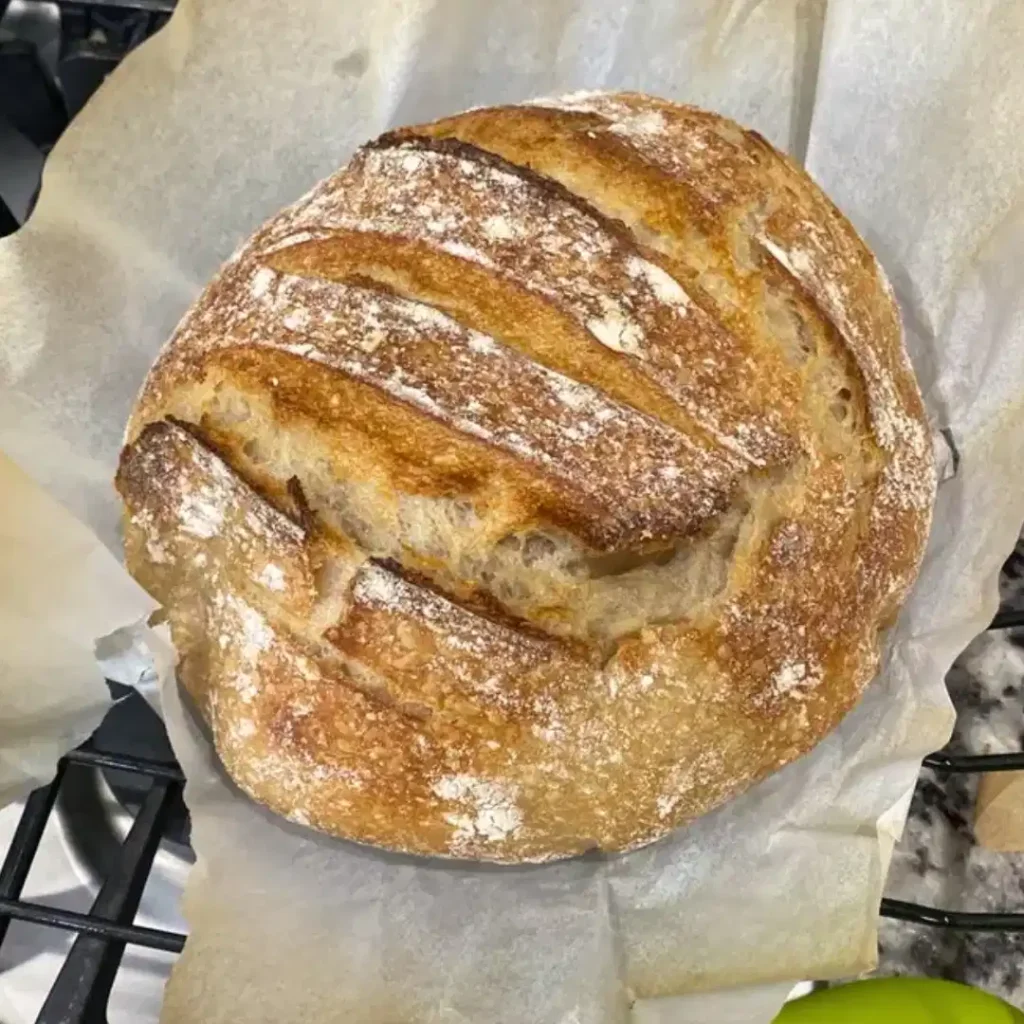Making sourdough bread is a rewarding experience that combines art and science. With just a few simple ingredients, some patience, and a little practice, you can create a delicious loaf of sourdough that is perfect for sandwiches, toast, or simply enjoying on its own. This guide will walk you through everything you need to know to get started on your sourdough journey.
Key Takeaways
- Sourdough bread is made using a natural fermentation process, which gives it a unique flavor and texture.
- Creating a sourdough starter requires mixing flour and water and letting it sit until it bubbles and rises.
- The key ingredients for sourdough include flour, water, salt, and an active starter.
- Baking sourdough bread involves several steps, including mixing, fermenting, shaping, and baking the dough.
- Storing sourdough properly can extend its freshness and flavor, making it a great addition to your meals.
Understanding Sourdough Bread
Sourdough bread is a special type of bread that stands out because it uses a natural fermentation process instead of commercial yeast. This means that it relies on a live culture called a sourdough starter, which is made from just flour and water. The result is a bread that has a unique tangy flavor and a chewy texture.
What Makes Sourdough Unique
- Natural Leavening: Unlike regular bread, sourdough rises due to wild yeasts and bacteria in the starter.
- Flavor Profile: The fermentation process gives sourdough its distinct taste, which many people find more enjoyable than store-bought bread.
- Texture: Sourdough has a crispy crust and a soft, airy inside, making it a favorite for many.
Health Benefits of Sourdough
- Easier to Digest: The long fermentation breaks down gluten, making it easier on your stomach.
- Nutrient Absorption: Sourdough can help your body absorb nutrients better than regular bread.
- Lower Glycemic Index: It may have a lower impact on blood sugar levels compared to other breads.
Common Misconceptions About Sourdough
- It’s Too Complicated: Many think sourdough is hard to make, but with practice, it becomes easier.
- You Need Special Equipment: You don’t need fancy tools; just a bowl and a baking sheet will do.
- It Takes Too Long: While it does require time, much of it is hands-off, allowing you to do other things.
Getting Started with Sourdough Starter
What is a Sourdough Starter?
A sourdough starter is a mix of flour and water that captures wild yeast and bacteria from the air. This mixture helps your bread rise. You can create your own starter in about a week, but it’s easier to buy one if you want to start baking right away. Here are some places to find a starter:
- Breadtopia
- King Arthur Flour
- Cultures for Health
How to Create Your Own Starter
Making your own starter is a fun project! Here’s a simple way to do it in 7 easy steps:
- Mix equal parts of flour and water in a jar.
- Cover the jar loosely and let it sit at room temperature.
- Feed it daily with more flour and water.
- Watch for bubbles and growth.
- After about a week, it should be ready to use.
- Perform the float test: drop a small amount in water; if it floats, it’s ready!
- Use it in your sourdough recipes.
Maintaining Your Sourdough Starter
To keep your starter healthy, you need to feed it regularly. Here’s how:
- If you bake often, feed it daily.
- If you bake less, store it in the fridge and feed it once a week.
- Always discard some starter before feeding to keep it manageable.
Essential Ingredients for Sourdough Bread
When it comes to making sourdough bread, you only need a few key ingredients. Here’s what you’ll need:
Choosing the Right Flour
- Bread Flour: This is the main ingredient. Look for flour with a high protein content, ideally between 11.7% and 12.7%.
- Organic Options: If possible, choose organic flour as it is free from harmful chemicals.
- All-Purpose Flour: This can also be used, especially for beginners.
The Role of Water and Salt
- Water: Use filtered or bottled water for the best results. The temperature of the water can affect fermentation.
- Salt: Essential for flavor and controlling fermentation. Use about 10 grams (2 teaspoons) for a standard recipe.
Importance of an Active Starter
- Sourdough Starter: This is the heart of your bread. Make sure it’s active and bubbly before you start baking. Feed it 4-12 hours before use to ensure it’s at its peak.
| Ingredient | Amount |
|---|---|
| Bread Flour | 500 grams (4 cups) |
| Water | 350 grams (1.5 cups) |
| Salt | 10 grams (2 teaspoons) |
| Active Starter | 100 grams (1/2 cup) |
Step-by-Step Guide to Making Sourdough Bread
Mixing the Dough
To start your sourdough journey, you need to mix the dough. Here’s how:
- Pour 375 grams of water into a large bowl.
- Add 50 to 100 grams of your active sourdough starter and stir well.
- Next, mix in 11 grams of salt.
- Finally, add 500 grams of bread flour and stir until everything is combined.
Bulk Fermentation Process
After mixing, it’s time for the dough to rise. Follow these steps:
- Transfer the dough to a straight-sided container and cover it.
- Let it rest for 30 minutes.
- Perform a set of stretches and folds every 30 minutes for the first 2 hours. You should see the dough getting stronger.
- Allow the dough to rise until it increases in volume by about 50%. This may take a few hours, depending on your kitchen’s temperature.
Shaping and Proofing the Dough
Once the dough has risen, it’s time to shape it:
- Turn the dough out onto a lightly floured surface.
- Shape it gently into a round and let it rest for 20-40 minutes.
- Prepare a bowl or banneton with a flour sack towel and rice flour.
- Shape the round again and place it in the prepared bowl for proofing. You can let it proof in the fridge for 12 to 48 hours.
Baking Your Sourdough Bread
Preheating and Preparing the Oven
Before you start baking, it’s crucial to preheat your oven properly. Set your oven to 500°F (260°C) and place a lidded cast iron pot inside. This helps create steam, which is essential for a good rise and crust. Let it heat for about an hour.
Scoring Techniques for Sourdough
Once your dough is ready, it’s time to score it. Use a sharp knife to make a slash about 2-3 inches long down the center. This allows steam to escape and helps the bread expand while baking.
Tips for Achieving a Perfect Crust
To get that perfect crust, follow these steps:
- Bake covered for the first 30 minutes at 450°F (232°C).
- After 30 minutes, remove the lid and lower the temperature to 400°F (204°C).
- Continue baking for another 15-40 minutes until the crust is deep golden brown.
- Check the internal temperature; it should be between 205-210°F (96-98°C).
- Let your bread cool on a wire rack for at least an hour before slicing. This helps avoid a gummy texture.
Troubleshooting Common Sourdough Issues
When baking sourdough bread, you might face some challenges. Here are some common problems and how to fix them:
Why Won’t My Bread Rise?
If your bread isn’t rising, it could be due to a few reasons:
- Weak starter: Ensure your starter is active and at its peak. If it’s not bubbly, it won’t help your dough rise.
- Temperature issues: Sourdough thrives in warmer environments, ideally between 75°F to 80°F. If your kitchen is too cold, your starter may not rise as expected.
- Over-proofing: If you let the dough rise for too long, it can collapse. Keep an eye on the time and the dough’s appearance.
Dealing with Sticky Dough
Sticky dough can be frustrating. Here are some tips to manage it:
- Use less water: If your dough is too sticky, try reducing the water in your recipe.
- Flour your hands: When handling sticky dough, flour your hands and the work surface to prevent sticking.
- Knead properly: Make sure you’re kneading the dough enough to develop gluten, which helps with structure.
Preventing a Dense Loaf
A dense loaf can be disappointing. To avoid this:
- Check your flour: Using too much whole wheat or rye flour can lead to density. Stick to bread flour for a lighter loaf.
- Active starter: Always use a well-fed and bubbly starter. A weak starter won’t give your bread the lift it needs.
- Follow the timing: Make sure you’re following the recommended rise times. Too short or too long can affect the texture.
By keeping these tips in mind, you can troubleshoot common sourdough issues and improve your baking skills!
Storing and Enjoying Your Sourdough Bread
Best Storage Practices
To keep your sourdough bread fresh, store it properly. Here are some effective methods:
- Place your loaf in a sealed or air-tight food container, like a Tupperware or a Ziploc bag.
- Alternatively, store it cut-side down on a cutting board, covered with a cake-stand top.
- Avoid refrigerating your bread, as it will become hard.
Creative Ways to Use Sourdough
Sourdough bread is versatile! Here are some fun ideas:
- Make delicious avocado toast.
- Use it for sandwiches with your favorite fillings.
- Create croutons for salads or soups.
Pairing Sourdough with Meals
Sourdough pairs well with many dishes. Consider these combinations:
- Enjoy it with soups or stews for a hearty meal.
- Serve it alongside cheese and charcuterie for a tasty snack.
- Use it as a base for bruschetta topped with tomatoes and basil.
Final Thoughts on Making Sourdough Bread
Making sourdough bread at home can be a fun and rewarding experience. With just a few simple ingredients and some patience, you can create a delicious loaf that’s perfect for sandwiches or toast. Remember, the key is to give your dough enough time to rise and develop its unique flavor. Don’t be afraid to experiment with different techniques and flavors as you become more comfortable with the process. Enjoy your baking journey, and don’t forget to share your creations with friends and family!
Frequently Asked Questions
What is sourdough bread?
Sourdough bread is a type of bread made from a fermented mixture of flour and water, known as a sourdough starter. It doesn’t use commercial yeast, which gives it a unique flavor and texture.
How long does it take to make sourdough bread?
Making sourdough bread takes longer than regular bread. The whole process can take about 22 hours, including creating the starter and allowing the dough to rise.
Why is my sourdough bread not rising?
If your sourdough bread isn’t rising, it could be due to an inactive starter or the dough being too cold. Make sure your starter is bubbly and active before using it.
Can I use regular flour for sourdough?
Yes, you can use regular all-purpose flour, but bread flour is recommended for better structure and texture. The higher protein content helps the bread rise better.
How should I store my sourdough bread?
To keep your sourdough bread fresh, store it in a paper bag at room temperature. You can also freeze it if you want to keep it for a longer time.
What are some ways to use sourdough discard?
Sourdough discard can be used in many recipes, such as pancakes, waffles, or even in baking cookies and muffins, so nothing goes to waste!



